Insect & Disease Conditions Update
The Maine Forest Service would like to remind everyone that August is Tree Check Month. Given the life cycle of some of the forest pests on Maine’s “most wanted” list, August is an especially important time to be on the lookout for invasive species. As summer begins to wind down, consider this as one more reason to get outside while the getting is good. Some steps you can take to help slow the spread of invasive forest pests include:

- Buy firewood where you’ll burn it or gather it on site when permitted. If you move firewood, you might move invasive insects and diseases hiding in or on it. Firewood is tied to the rapid spread of emerald ash borer (EAB) and it is responsible for movement of Asian longhorned beetle, brown spruce longhorned beetle, oak wilt, spotted lanternfly, beech leaf-mining weevil and more. The reasons we know we shouldn’t move firewood are too long to detail in this bulletin. We also know that new significant forest health threats arrive steadily from other regions, at a pace of approximately one every 2.5 years. Learn more about the importance of not moving firewood at the MFS firewood site.
- When traveling locally or moving to a new area, check your bags and boxes to make sure they are insect-free. Invasive species can get in and on bags, boxes, vehicles and other items that have been stored outside or in you garage.
- Choose your landscape material wisely. Some invasive species, such as winter moth and invasive plants, move in soil; many others move on plants.
Invasive insects such as the spotted lanternfly can move on plants. See below for an image with the SLF egg masses highlighted. Photos used by permission, Colin Purrington
|

- Consider invasive species when choosing species to plant. For instance, the DACF suggests that people refrain from planting any kind of ash tree (Fraxinus) or white fringe tree (Chionanthus sp.) in the state since EAB is established in both northern and southern Maine and because the state is also surrounded by EAB infestations in New Hampshire, New Brunswick and Quebec. Ornamental ash in areas with EAB require regular insecticide treatments for survival.
As always, you can reach us with concerns or observations about forest health on our tree ailment form or by calling (207) 287-2431.
|
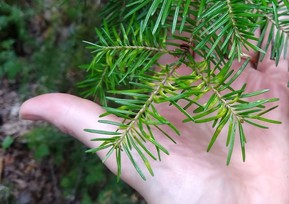
Balsam Gall Midge (Paradiplosis tumifex)
Image: Balsam gall midge galls presenting as small yellowish swellings near the base of fir needles that will eventually be shed from the fine branches, leaving unsightly voids in the foliage. MFS
While most would agree it’s still a bit too early to start decorating for the holidays, it’s not too early to be thinking about insect pests like balsam gall midge that can cause serious economic consequences for Christmas tree growers and wreath makers. Galls formed near the base of needles by this insect are unsightly and lead to premature needle drop, affecting the overall aesthetics of trees and boughs so highly valued for the fullness of their foliage. Though the damage in Maine appears to be scattered at this point, there have been sufficient calls and observations made over the past two seasons to urge Christmas tree growers to increase their monitoring efforts, and caution against collecting wreath brush with excessive galling this fall (galled needles will drop soon after collection if they haven’t before harvest time).
Mature midge larvae overwinter in the soil and pupate the following spring, with adults typically emerging in May in time to lay eggs in developing shoots just prior to bud break. Galls become noticeable during the summer months and usually drop to the ground in late summer and fall to continue the life cycle, leaving behind noticeable voids in the foliage along the fine branches when populations are substantial. Trees may then need several years to recover before old balsam gall midge damage can be sheared in order to create marketable trees or boughs again.
It is too late for management this season, but Christmas tree farms with low damage thresholds will want to scout in order to prepare for next year. The University of New Hampshire suggests an economic treatment threshold once 10% of current-year shoots are galled. Damage assessment for this threshold must be performed in the fall due to treatment timing and waiting to quantify new galls in the spring will result in missing the treatment window. Treatments should be undergone with due consideration, since chemical management also kills the natural controls of balsam gall midge.
|
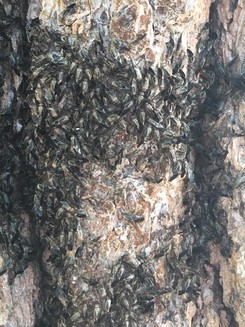
Barklice (Cerastipsocus venosus)
Image: Adult barklice photo sent in by a homeowner in Belgrade. MFS
We have received many reports of “mystery insects” on the bark of trees and have had a few samples come into the lab. The small, soft bodied mystery insects, shown in the image, are barklice. Interestingly, they are indeed related to the lice people get in their hair, although distantly and pose no problems for humans. Barklice are completely harmless and actually benefit the tree by consuming detritus and other organic bits found on tree bark, especially on maples. Think of them as little herds of buffalo roaming and grazing the vast plains of tree trunks. There are many species of barklice in Maine, however C. venosus is probably the most conspicuous and therefore the most often seen. These barklice appear in July as patches of tiny tan specks on the bark of various hardwoods and conifers. Juveniles are striped and wingless, and adults have dark smoky-gray wings with a triangular light spot on each forewing. In late summer, adult females will deposit their eggs singly or in small clutches on the bark covering each mass with a series of tiny silk strands. These egg masses will overwinter until emergence next year. Barklice usually disappear from trees soon after they develop wings in mid-to late-August.
|

Browntail moth (Euproctis chrysorrhoea)
Image: Beginnings of BTM winter web on a pear tree in Manchester. MFS
With the departure of adult browntail moths (BTM), there was a lull in BTM activity. Now, the egg masses that were laid in July have begun to hatch, ushering in a new generation of caterpillars. These young caterpillars do not have the irritating hairs for which older BTM caterpillars are infamous. While feeding they graze/consume the outer layer of the leaf, a type of damage called skeletonization. In the case of BTM, this causes the leaves to die and turn a coppery/ bronze color, a characteristic used by MFS staff to detect BTM defoliation during late-summer. Homeowners can also use this skeletonization to determine the level of BTM in their trees, although this admittedly is not as effective as looking for winter webs once leaves have fallen—it can be harder to spot, and there are many other insects that cause similar damage.
In addition to feeding, the little caterpillars have begun creating the web inside which they will spend the winter. Currently, these webs are tiny and measure about 1.5”–2”, making them barely noticeable at this stage. Please see the section that details the differences between BTM winter webs and our native web builder fall webworm.
|
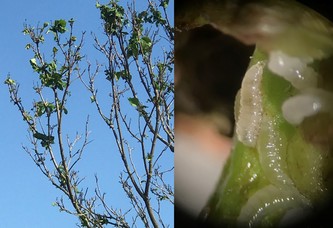
Catalpa midge (Cecidomyia catalpa)
Image: Damage to catalpa leaves and the insect causing it, likely the catalpa midge. MFS
And for something rather more obscure, we have the mystery of what was attacking a catalpa tree in Freeport. In the early summer an arborist had sent in pictures of damaged leaves, but the insect larvae were too tiny to even properly see. A sample was sent to us, but that also proved inconclusive. After a site visit, we confirmed that the culprit was a tiny larval fly, hidden in the developing leaves. Although it is very difficult to definitively identify fly larvae, it is most likely the catalpa midge. There is very little in the literature about this midge. A paper published in 1908 suggests that there are probably multiple generations a year, which is consistent with the arborist’s observations, and they drop to the soil to pupate. In the only other mention of it found, it was suggested that the catalpa midge is generally a minor annoyance, and rarely (if ever) problematic. In this case, however, the midge appears to have caused significant leaf dieback and decline over the past few years. We are currently attempting to rear the larvae that were collected. Catalpa is not common in Maine, but if you see leaf dieback similar to this, look for this insect. Our thanks to the landowner and the arborist for their help in solving this mystery.
|
Eastern Spruce Budworm (Choristoneura fumiferana) – The 2020 spruce budworm flight season is winding down and it looks as though Maine may have been largely spared from any major in-flights of migrating moths from Canadian outbreak areas to the north. Large in-flights during the 2019 season are likely the reason that spruce budworm larvae were more easily found in 2020 than any time in recent history. Pheromone traps remain out in the field at this point to catch any stragglers, but soon the call to collect traps will come and the time-consuming task of counting adult moths for the 2020 trapping season will begin. Based on growing numbers over the last several seasons and our knowledge of larval activity on the ground this summer, we expect another increase in the overall numbers of adult moths captured in 2020. We have also recently completed aerial survey for northern Maine, however no signs of spruce budworm defoliation were visible from the air at these population levels.

Emerald Ash Borer (Agrilus planipennis)
Image: Map showing purple prism trap locations throughout Maine for the 2020 field season. MFS
Maine remains in the period of peak emerald ash borer (EAB) activity and we remain on high alert for new detections statewide. In late July, our intrepid interns and field technicians performed the first round of checks of our purple prism trap network. We are pleased to report that no EAB were recovered on these traps at this point in the season, however this is only one of the EAB monitoring techniques we employ.
One of the other ways we look for EAB is with the help of the non-stinging native wasp called Cerceris fumipennis. It commonly lives in areas of disturbed ground (often places like baseball diamonds) and normally feeds on our native buprestid beetles related to EAB. We regularly monitor known colonies of these wasps to look at the prey they bring back, a method known as biosurveillance. In July, we found that wasps in a colony in Kittery were returning with EAB, confirming its presence in a second area of this town (it had previously been found in a girdled trap tree in Fort McClary State Park).
A second find, this time in Ogunquit, was reported by a landowner who felled some unhealthy-looking ash trees and peeled back the bark. He discovered larvae and their signature galleries under the bark and sent in pictures, allowing us to confirm the presence of EAB. These new EAB finds remind us that we must continue to be vigilant when it comes to invasive forest pests. Collecting suspect insects and placing them in the freezer (this slows the insects down for easier photographing), and sending us pictures can help us identify them, and we appreciate your assistance.
|
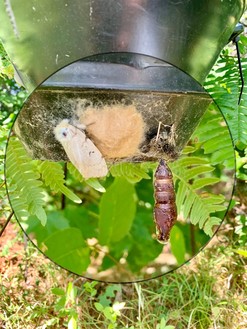
European Gypsy Moth (Lymantria dispar)
Image: An empty gypsy moth pupal case and newly emerged female gypsy moth depositing a fresh egg mass on an MFS funnel trap. MFS
The influx of calls caused by mature gypsy moth caterpillars last month has now been replaced with reports of abundant male moths flitting around while female moths are busy depositing egg masses on trees and other objects. As reported last month, weather patterns in 2020 have likely led to increased caterpillar survival and bolstered the background population level of gypsy moth around the state. Reports from new areas will help allocate survey efforts for gypsy moth egg masses, now that oviposition has occurred, we welcome reports of abnormally high numbers of egg masses for our records.
Insect surveys often involve a great deal of effort just to locate target species, but fortunately female gypsy moths are not too particular about oviposition sites. The included photo, taken in Fryeburg, ME, demonstrates just that. This female gypsy moth has chosen to pupate and then deposit her egg mass on a Lindgren funnel trap used in our exotic woodborer and bark beetle survey program. This serves as a reminder that gypsy moths will readily deposit egg masses on artificial surfaces, making things such as recreational vehicles, boats, and trailers all prime vectors for the accidental transport of gypsy moth to new areas.
Bitter cold temperatures and natural predators that consume gypsy moth egg masses, such as mice, provide some population control over the winter months. You can also actively participate in gypsy moth population control on your own property wherever gypsy moth egg masses are found. Where accessible, egg masses can be scraped off trees, rocks or other surfaces into a container of water and dish soap. As with all insect management, make sure all the necessary precautions are taken to avoid any discomfort. Be especially mindful if performing egg mass removal overhead, as personal experience can tell you that the hairs and scales from female moths used in egg mass construction can cause eye and skin irritation.
|
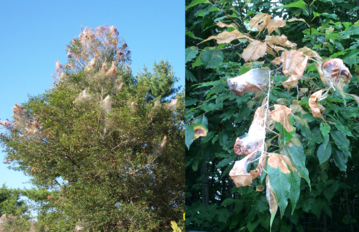
Fall Webworm (Hyphantria cunea)
Images: Comparison of fall webworm (left) and browntail moth (right) feeding damage on black cherry. Both images taken in the last week of August (2007 and 2016, respectively). Note the abundance of tightly woven silk on the cherry twigs infested with browntail moth as one clue to the identification. MFS
With browntail moth weighing heavily on our minds throughout most of the growing season, it can be easy to forget that there is a huge diversity of other caterpillars in Maine. One such example is fall webworm, a native, late-season defoliator that becomes most active and noticeable at this time of year. Fall webworm looks to be having a strong season, but this species is quite low on the list of concerns in regard to tree health. The late-season damage is well tolerated by host trees. From the standpoint of our education and outreach mission however, we are concerned with ensuring that Maine citizens can quickly and easily tell the difference between fall webworm and its most common case of mistaken identity, browntail moth.
Here in mid-August, fall webworm development has already progressed to the point where large, mature caterpillars have constructed loose sprawling masses of webbing and many are wandering freely from their webs. These caterpillars are almost uniformly more than 1” long. Fall webworm has a large range of host trees, including many of the same species browntail is found on. Their webs are often most noticeable on roadside trees, sometimes engulfing several feet of a colonized branch.
In contrast, immature browntail moth caterpillars are newly hatched and just beginning to feed. The caterpillars will generally not exceed ¼” in length until next spring. Browntail moth skeletonizing damage can be extensive in late-summer and early fall, but by mid-fall the nests will be quite compact. Feeding is most often restricted to the outer- and upper-most branch tips of host trees and the nests will remain firmly in place throughout the winter months, long after the degraded remains of fall webworm webbing has been eliminated from the trees by fall leaf drop and winter snows.
|
Oak tip dieback: Oak twig pruner (Anelaphus parallelus), Kermes scale (Allokermes kingii) and Bot canker (Diplodia coritcola) – Oaks in Maine suffer a series of seasonal attacks by a host of insect and disease organisms, some less severe than others. Damage to the finer branch tips is a symptom that has been reported and noticed frequently in the past few weeks. Diagnosing branch tip dieback in oaks is not always straightforward, as a closer look is often required to determine the casual organism. Three tree pests commonly causing tip dieback of oak this year are oak twig pruner, kermes scale infestation and bot canker of oak.
Kermes scales are often present in high numbers when damage is noticeable. The scales resemble small marbles or shells stuck to branches (Figure, left), with the females being up to ¼” in diameter. This species tends to aggregate around leaf nodes, feeding on sap. This aggregated feeding can cause tip/ small branch dieback and eventual breakage due to the weakening of the branch tip and wind.
Another cause of branch tip breakage is the oak twig pruner. Adults of the oak twig pruner (Figure, middle bottom left) fly about the time the oak leaves are beginning to form, and deposit eggs near the tips of twigs. The young larvae (Figure, middle, bottom right) mine down the stems, increasing in size, until late summer. They spend the first winter within the twig, usually near a node or thickened area. They resume feeding the second season and soon begin their pruning cuts beneath the bark. Larvae cut around the branch except for the thin bark so that the branches break with the wind and fall to the ground. The larvae remain in the fallen branches for up to several months, pupating in the fall. A related species of twig pruner, A. villosus, also occurs in Maine and prunes twigs and branches from an even wider variety of hardwood hosts, but is noted to prefer weakened, dying and recently dead hosts. A good cultural practice for reducing twig pruner in your area is to collect pruned twigs containing the larvae and destroy them.
‘Bot canker’ is the name used to refer to canker and tip blight symptoms on oak caused by native fungi in the genus Diplodia (formerly Botryosphaeria, hence the common name ‘bot canker’). The species D. corticola has been confirmed in Maine and has been recorded in several locations in Southern and Central Maine in recent weeks. Bot canker is usually associated with stress, as healthy oaks are typically not affected by this. A potential stressor, and possibly the reason for increased reports this year compared to 2019, was the June 2020 drought. What differentiates bot canker from oak twig pruner is a discolored, swollen and elongated section on infected fine branches just below the symptomatic outer portion of the twig (see image). The branch is not hollow, as in the case of twig pruner and there is no evidence of the round-shelled kermes scale in the area.
A potential complication to this is that it is possible for any combination of these disorders to co-occur on the same tree at the same time. So, it is important to closely examine several symptomatic twigs to confirm the specific causal agent of decline before thinking about treatment, which is seldom warranted. In conclusion, a positive thing that all three of these agents have in common is that none of them are serious pests of oak and their populations rise and fall in response to biotic and environmental conditions and are usually brought into balance by predators, cultural practices and conditions that support tree vigor. If your oak tree is showing symptoms different to those described here, and is, for example, showing larger areas of wilt, rapid decline, or is dropping its leaves, please contact the Maine Forest Service (aaron.bergdahl@maine.gov; (207) 287-3008).
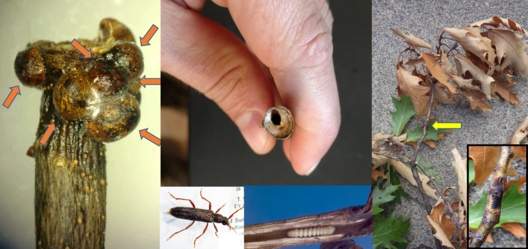 Images: (left) Kermes scale congregated around the leaf node of a fine oak twig; (center top) A cross-section of an oak twig showing the hollow center made by the larvae (center, bottom left) which will pupate into adults (center, bottom right) after the twig breaks and falls to the ground; (right) A blighted twig showing bot canker symptoms and a close-up of a bot canker (inset). MFS, MI State (twig pruner adult), James Solomon, USFS (twig pruner larva).
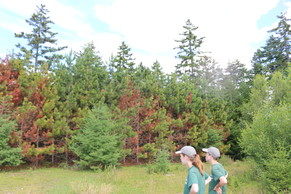
Red Pine Scale (Matsucoccus matsumurae)
Image: MFS interns survey red pine scale damage to red pine in Surry, ME. MFS
The slow and unfortunate saga of red pine scale in Maine continues with another recent detection in Hancock County on the South Surry peninsula. Again, this is not surprising given the proximity of this latest find to the core Mount Desert Island area where red pine scale was first detected, and wind driven dispersal. It is well known that there is significant red pine decline on Mount Desert Island and the surrounding areas on the mainland, however red pine scale is not always found associated with these declining trees. Therefore, it remains uncertain to what degree red pine scale is a driver of this decline, or whether it perhaps plays only a supporting role in a larger decline-causing complex.
|
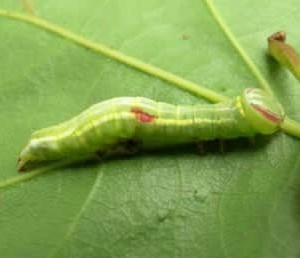
Saddled prominent (Heterocampa guttivitta)
Image: Saddled prominent larva. MFS
The saddled prominent is an important hardwood defoliator that may cause significant damage to the forest resource. Larvae defoliate hardwood stands through the month of July and into early August. Beech and sugar maple are the preferred hosts, but birches and oaks may also be defoliated. Two successive years of severe defoliation may cause some dieback or tree mortality of already weakened trees on poor sites. Outbreaks appear suddenly and do not seem to follow any particular cycle. However, heavy infestations usually subside after one or two years in any one location. Natural control factors such as starvation, disease, parasitism, and predation combine to bring about a collapse of these outbreaks.
We have received a report of saddled prominent activity in Township D (Oxford County) from Seven Islands Land Company Forester Walker Day and reports from New Hampshire Division of Forest and Lands Forest Health that populations are up in New Hampshire, with defoliation observed in the southwestern part of that state.
We appreciate reports of increased caterpillar activity, especially with accompanying photos.
|
Abnormally Dry and Drought Conditions -- Maine continues to experience abnormally dry and drought conditions throughout most of the state. As of this week, only 7.5% of the state is not in at least abnormally dry conditions. As stated last month, trees with predisposing stressors and trees that are not yet fully established may have the most difficulty coping with the lack of water. While some symptoms have been immediately obvious, other symptoms may come later, even after the recent rise in rainfall totals in some parts of the state. As referred to later in this section of the report, drought can be a significant primary stressor, leaving trees more vulnerable to secondary agents of decline. Find the most recent data by accessing the drought monitor.
Hail Damage
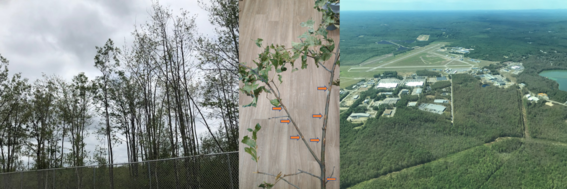 Images: (left) Silhouette of hail damage near the Sanford Airport showing extent of tree defoliation of multiple species; (middle) A branch with multiple injuries exposing the inner bark due to hail impacts; (right) Aerial image of the affected area, impacted areas appear grayish. Kurt Woltersdorf (trees), MFS (branch, aerial image).
A hail event in the Sanford area caused serious damage to trees in a roughly 1000-acre area centered along Rte. 109, west of the airport. Various levels of damage to peripheral areas was estimated to comprise an additional 500 acres. The hail was large enough and the storm intense enough that many trees were heavily defoliated and damaged. The most severe impacts of this hail event may still be to come, as the numerous points of damage to the bark of trees serve as infection points for pathogenic tree fungi such as decay and canker fungi. In areas where the bacteria that causes fire blight is present, orchardist and home fruit growers tending trees in the family Rosaceae (pears, apples, cherries, etc.) may notice a sharp increase in infections. Diplodia tip blight of red and mugo pine (Diplodia pinea) infections have also been reported to increase following hail events in the Midwest; the same relationship could be expected to occur in Maine.
Scrub Oak Dieback – Large-scale damage and dieback to scrub oak was seen in several areas of southern Maine in late July 2020. Three major areas were identified in Fryeburg, Hollis and New Gloucester, although it is likely that other areas experienced similar damage. Firstly, the scrub oak seems to have been impacted by the late frost event reported in June’s Conditions Report (#3 of 2020). The impacts of the frost may have been greater due to the oaks growing closer to the ground where lower temperatures are experienced and the tendency of scrub oaks to grow under sparse canopy cover. However, this was likely just the beginning of story, since the oaks that lost many leaves were trying to re-leaf just as the June drought hit. This resulted in arrested and aborted leaf development and small discolored leaves. Further, in some areas oak anthracnose (Apiognomonia quercina) was seen, as well as impacts from the oak leaf shothole leaf miner (Japanagromyza viridula). Together, these dismal conditions for scrub oak and some red oak regeneration led to noticeable, and severe impacts.
A new Guide to Bark Beetles of Northeastern Pines
The U.S. Forest Service has developed an Identification Guide to Bark Beetles of Northeastern Pines. This guide outlines the biology and identification of common phloem-inhabiting bark beetles that you are likely to encounter during southern pine beetle surveys. It includes a pictorial key to the species in the guide and loads of detailed images to help you make accurate identifications, an important first step to making appropriate management decisions. Download Bark Beetles Guide (PDF)
Wednesdays thru September 2, 3:00-4:00 pm – As part of the 2020 New Hampshire Forest Health Webinar Series, Mike Parisio will co-present with Kyle Lombard (Forest Health Program Coordinator, NH Division of Forests & Lands) on Spruce & Fir Issues in Northern New England on September 2, 2020 at 3:00 PM.
Monday August 24, 2020, 10:30am-12:00pm – The Maine Department of Agriculture, Conservation and Forestry is hosting a quarterly conference call to update city and town tree and forest managers, as well as public works staff, on the known status of emerald ash borer in Maine, current state efforts, municipal opportunities, and plenty of time for Q&A. The call will begin at 10:30 AM on Monday, August 24th and will run no more than 1.5 hours. This quarter’s call will take place on the Microsoft Teams platform. You can join the meeting, even without a Microsoft account, you can also join by phone: +1 207-209-4724, United States, Portland (Toll), Conference ID: 650 950 337#. Please share with municipal tree managers and others within your Maine community government who may be interested (tree warden, arborist, public works, parks, transfer station, etc.). 1 Maine Pesticide recertification credit available. *Those seeking credit must pre-register by contacting Stephen Nicholas at Stephen.J.Nicholas@maine.gov.
Thursday August 27, 6:30 pm - BTM presentation for the town of Hope, link for Zoom meeting.
Office hours are 7:30 am to 4:00 pm, Monday through Friday, except for holidays. However, we are currently working remotely and DACF buildings are closed to public access. You can still reach us at: (207) 287-2431. Status of the building closure will be updated on the DACF homepage, www.maine.gov/dacf.
NOTE: The Augusta office is now housed in the Deering Building, 90 Blossom Lane, Suite 201. The mailing address and phone numbers are unchanged. A map is available on our website. The lab at 50 Hospital Street is currently housing the Kennebec County Soil and Water Conservation District.
Conditions Report No. 4, 2020
Past On-line reports available here.
Department of Agriculture Conservation & Forestry
Maine Forest Service – Forest Health and Monitoring
Contributors: Aaron Bergdahl, Mike Parisio, Thomas Schmeelk, Regina Smith and Colleen Teerling
Unless otherwise noted, photos by Maine Forest Service, Forest Health and Monitoring, DACF
|